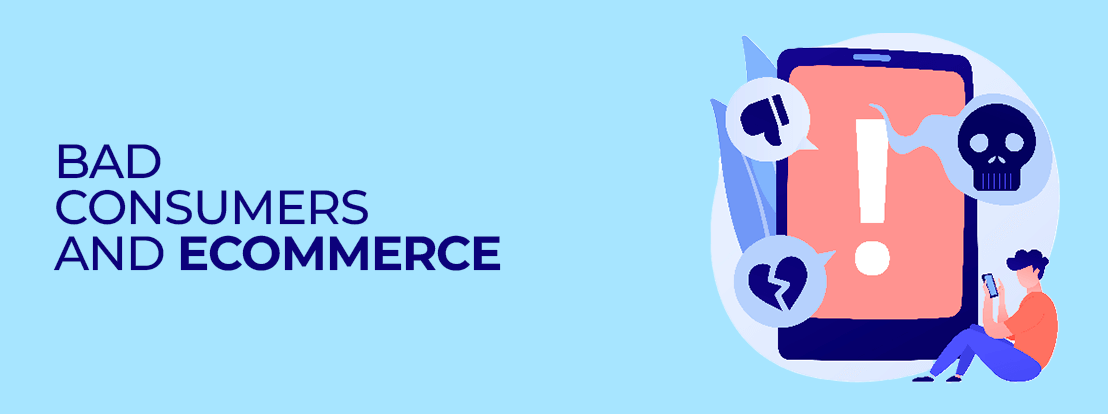Table of contents
How to identify bad customers?
Ecommerce represents a series of changes and advantages at the time of buying that are so new for many people that, for some people, it is difficult to understand the limits or concepts of this way of buying and selling, making them use incorrectly or abusively all the ecommerce tools they have at their disposal. Let’s not fool ourselves, not all of them are out of ignorance, many others do it knowingly, trying to take advantage of the “holes” that we leave in our ecommerce strategy and that make us vulnerable to bad practices.
The Internet is no longer something new, no matter how much the TV news keep trying to call it “new technologies”, it is something that has been with us for more than 20 years, so people have more and more experience in developing themselves through the different tools it offers us, and that has generated the appearance of many people who, as in the real world, try to outsmart the system itself and the rest of Internet users, making a profit to the detriment of another. Our role as shopkeepers should be that of a rancher, defending our territory against outlaws with a calm and thoughtful attitude. We should not shoot at them as if we were their equals. We must never forget that this is a company and we must exude professionalism in every action we do or thing we say.
First of all, let’s try to list the different characteristics that define the different types of bad customers to help us identify them before they become a bigger problem.
The “freaks
As I mentioned in the intro, there are people who find online shopping so new and different that, due to their lack of knowledge and impossible-to-meet expectations, it can be a problem. There is almost nothing you can do to please them, even when you have done everything right. They are the kind of customers who ask for impossible requests, discounts for everything, “bartering” that borders on illegality. They don’t care about your business, nor are they empirical or knowledgeable about what it means to have a business (they think you have to do everything for free). If your store does not quickly identify this type of bad customer and does not communicate and close the issue correctly, it can cause us a lot of problems (especially because they usually leave a record of their indignation with lengthy comments about our “bad service”). Verify that all the information and conditions of your store, the purchase process, refund policies, shipping, return… are as clear as possible so they can not catch you in anything and you have a “bulletproof vest” when they try to attack us with impossible requests.

The “freeloaders”
On the internet there are some very “cool” people who have learned to profit from the buying and shipping processes of online stores. They are not scammers in the very name of the word, but their practices are of dubious integrity. Their goal is not to steal from you but to get something for nothing, to cheat you in order to make a profit. A very common practice is to order low cost products and then claim the money back. The amount of the products is so little, that the cost of the return, in terms of transportation, is higher than what you would get with the refund of the products, so the merchant is not worth claiming them back. So the customer keeps the products and the money refunded. If they do well, they repeat, so beware of customers who have requested a refund on more than one occasion (check the amount of the products).

The “absent-minded
This type of customer could also be called “the rogue”, because they use the emotional factor to make a profit. Their modus operandi is similar to that of the rogues, but with an occasional lack of attention. Often an order is correct, everything is fine, and the customer asks for a refund claiming that he did not know how to use the store very well and has bought by mistake, making his refund less than the shipping cost and getting two orders for the price of one. The merchant himself decides to “take pity” on him, since he always says that they are older people who “don’t understand much about the Internet and wanted that product as a gift for their grandchild”. Most of the time it is not even true and there is neither grandfather nor grandson, they just play a role. Other times the order you wanted to place was different from the one you placed but “as you don’t know”, you placed that “unintentionally”. Or he requests a change of delivery address at the same moment he receives the package, because he “got confused the first time”, just before the delivery person has updated the delivery info, and then claims that it never arrived, requesting a new one. They usually use this until they get it wrong once and never come back to the store.

The “bad guys”
This type of bad customer, fortunately, is not very widespread. It is possible that in all the time you have an online store you will only come across one of this type, or you may even be lucky and never come across one, but if you do, you will remember it for the rest of your life as an online merchant. If the bouncers used practices of dubious integrity, these ones directly use coercion as a form of scam. They often choose to threaten to sue or report your business to a consumer group and to bad-mouth you on social media and public store profiles. The goal is to intimidate you into giving in and giving them what they ask for in exchange for not making your life difficult. He usually also uses provocations and exaggerated insinuations about business failures, to make us nervous and weak when it comes to responding. Although it can be emotionally overwhelming, the first advice I give you is not to get carried away by the “heat” and end up falling into their game, as this will weaken you a lot in front of any other customer seeking information about your business (to see an argument between a customer and the owner of the store is something embarrassing).

The “belenesteban”
There are people who are aware that their arguments when arguing are not very consistent, so they use coarse language, swearing and verbal abuse as a force when launching their retorts. These are the type of people who like to say things like “I speak in silver” or “things by their name”, but who really use this form of communication as a form of intimidation to obtain a benefit in return. If there has been some kind of problem, we must have a little more patience and “broad sleeve” when dealing with these people, since we can be sympathetic to their anger, but in no case can we tolerate insults or abuse of any kind. When that happens, we must cut off communication and make it clear that such manners are not allowed in our business. Generally they make a lot of noise, and try to be noticed a lot, but as soon as the conditions are made clear to them and they are invited to speak politely, they tend to fall under their own weight until they abandon the conflict out of sheer embarrassment.

how to avoid bad customers?
When you are regularly confronted with some kind of bad customer, it is because you are doing something wrong. You’re being spread too thin and attracting the wrong kind of people for the business. You are reaching people who are neither interested in your business nor interested in your products, so you have to get to work to make the appropriate changes in your ecommerce that will allow you to get your business back on track.
Define your audience: One thing that the inexperienced seller thinks is that he wants to reach “as many people as he can”, without stopping to think that what he sells will probably only interest a very specific type of person. Does it make sense for me to invest a lot in advertising to young people if I sell fur coats over 2000 €? Or trying to sell products of bad and cheap brands in a forum of Apple addicts? No, isn’t it? Well, this is the same thing. You have to concentrate your efforts on reaching and convincing the people who are interested in what you are selling. It is as important to define your audience as it is to try to think like them. What and how are these people looking for? How do I reach them? What would I do if I wanted to buy something I sell? It is very important to know how to reach your audience because they will be the ones who will define your communication and the type of business you should have.

Transparency to achieve quality: Stop using bad “tricks” to falsify prices, show the total price, including taxes and transport costs. Do not obsess that your final price is a little higher than that of other competitors and that makes you look less attractive to the sale, you have to make clear all the info in the product sheet itself and in the cart Will you expect customers? It is possible that some, but you will scare away those you do NOT want as customers. The bargain hunters who only look at the offer and compare in 30 sites before deciding. They will not be loyal to you and, above all, they will complain a lot when they get to the final payment process with harmful comments, making your online reputation more negative. Bet on a quality clientele.
Volume sales: A good way to climb the ladder and avoid bad customers is to increase the number of units sold so that bad customers do not represent a balance to be taken into account in the total sales computation. This can be achieved by selling many more products per order and for this we can use volume sales, as if we were a wholesaler. Why not include a small button or pop-up that informs your customers that they have the possibility to request a quote for large orders? Not only you can get very interesting orders, but you open up a new world of wholesalers in which the “bad customers” will be like mosquitoes crashing against the windshield of your car, because they will be a handful of units within a gigantic stock, so the cost per unit is infinitely smaller and therefore more negligible. In this way you will not avoid bad customers, but their impact will hardly have any impact on you.
what to do with bad customers?
If, despite having applied the above tips, we have not managed to get rid of the old bad customers that we have been dragging along from before, what should we do with them? Refuse to process more orders? Try to unmask them in front of everyone? No, because that will not only make us fall into their game, but it will also make us look very unprofessional and we can even provoke the opposite effect and make the rest of the people take their side (it is a very dangerous game), besides that person can use other data (those of his partner, a friend or a relative) to do it again. The solution lies in having a sales strategy that attracts quality customers and a “filter” to file the “bad customers”, with whom we will work from now on.
Segregate
The first thing you have to do is to identify each and every one of the “bad customers” you have. Making separate lists from the rest of the customers. That is, regardless of the different groups or categories into which you have organized your user lists, you should have a specific database of bad customers.
Feed the good ones and punish the bad ones
Once you have made this list, you can begin to act in two clearly divided groups: those who spend and those who annoy. The former receive timely information, discounts and privileges; the latter are blacklisted.
Recycle
Try different newsletter techniques on that blacklist, and see if you can convert them into good customers. Some interesting options are to offer outlet products or seasonal surplus and try to attract them to a community in social networks around our store
Eliminate
If despite trying several things you don’t manage to “convert” these bad customers, the best thing to do is to stop investing time and money in them and eliminate them as customers. If they appear again, we will try to process them as any other order, and if they put too much insistence on bad attitudes, the best thing to do is to cut the communication with a dry “from this moment on, the conversation passes into the hands of our lawyer”, to make it clear that the nonsense is over and that if you want to continue with this game it will be through the courts. This is usually enough to scare off any kind of bad client.
Now that you know what they are and how to deal with them, you can start building your attack and defense strategy in case of a new encounter with them. Bad customers are the “trolls” of the ecommerce world, so it is important to be aware that, sooner or later, you will encounter one of them. Inevitably, even if you try to do everything right, the world is very big and if in the real world you meet undesirable people, on the Internet it seems almost impossible not to. But the important thing is that you must keep calm, not get caught by their childish games or threats, and try to turn the situation around, turning it into something positive for your ecommerce. Generally, people are not usually too insistent and, in fact, most of the possible bad customers can become a simple scare with a small apology, a merchandising gift, a small discount … it’s a bit “Dr Jekyll and Mr Hyde” in digital version, but being easy to calm the beast. Of course, if things get serious, and you start talking about complaints or legal systems, the best thing to do is to put the case in the hands of your lawyer or a legal advisor, and start to treat it from a more studied perspective, just in case this could jeopardize the continuity of your business.
And if we can lend you a hand in something, either in improving your online store or in helping you to solve a specific conflict (remember that we work with a legal advisor specialized in ecommerce), do not hesitate to write us, call us or tell us so we can help you. We have many years of experience in ecommerce (and in internet in general) and we can guarantee that we have encountered all kinds of negative experiences (fortunately, there have been more positive ones) and that we know how to give a solution to the one you have at that moment.

Related Posts










Deja un comentario